|
The Chapel of Hathor - Description |
update:
03.01.2012
|
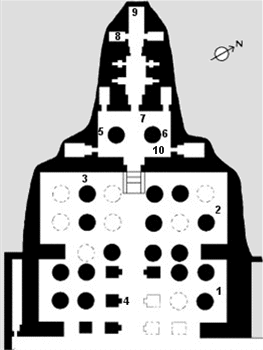
| Above the floor plan of the Chapel of Hathor with the
location of various scenes.
|
| 1 |
Hathor-Cow inside a shrine;
opposite wall:
Hathor-Cow in a shrine is suckling and
protecting the royal child |
| 2 |
Procession of Hathor with barques and soldiers; in the
northwestern corner Thutmosis III is shown with an oar before Hathor |
| 3 |
from left to right, left (south) of the entrance:
ritual run with bird before Hathor,
Hathor-Cow licking the hands of the queen;
right (north) of the entrance:
Hathor-Cow licking the hands of the queen,
ritual run "Seizing the Oar".
|
| 4 |
Pillars with Hathor-standards, columns with Hathor-heads |
| 5 |
Weret-Hekau offering a menat to Amun |
| 6 |
Hatshepsut before Hathor |
| 7 |
Royal titles on lintel and jambs, on both sides two Hathor-standards
(see photo below) |
| 8 |
Portraits of Senenmut |
| 9 |
Hatshepsut (replaced by Thutmosis III) embraced by Hathor,
both before Amun |
| 10 |
Hatshepsut (replaced by Thutmosis III) playing ball before Hathor |
|
|
According to Wysocki (1992) the purpose of the small room south of the
Chapel of Hathor is not known. |
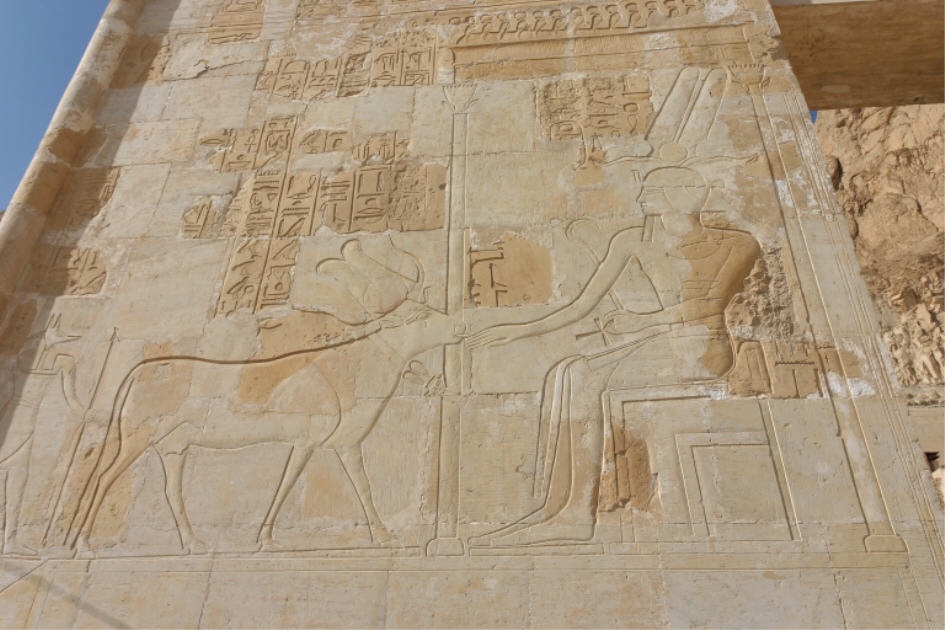
|
Left (south) front of the Chapel of Hathor.
|
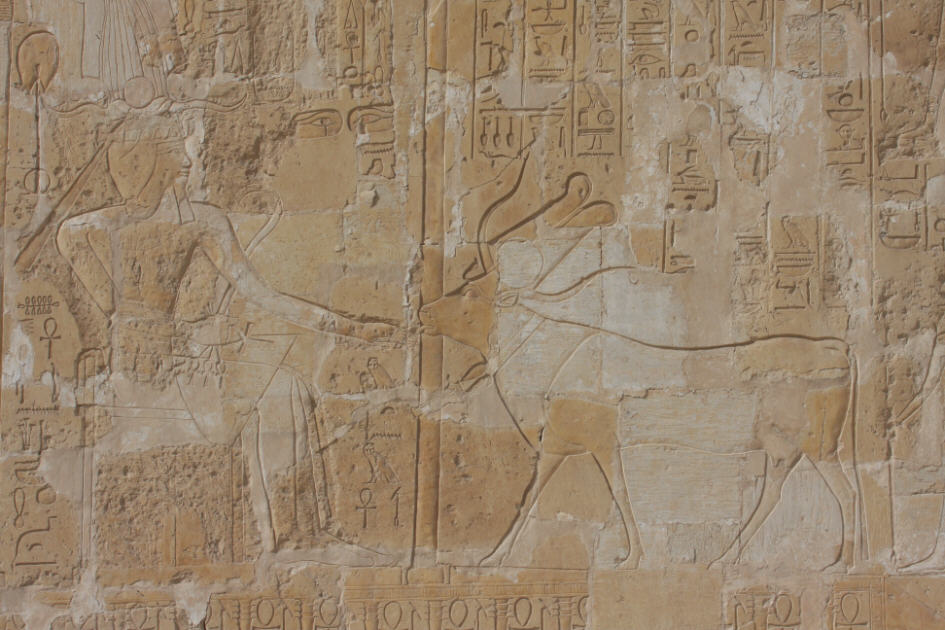
|
Right (north) front of the Chapel of Hathor.
|
| On both sides of the front the Hathor-Cow is depicted, followed of Anubis,
licking the hand of the queen, who is sitting under a canopy on a throne. The cartouche of the queen
had been changed in both cases to the throne name (Aa-kheper-en-Ra) of her
husband, Thutmosis II. The canopies are decorated with an uraeus-frieze and
supported with Lotus-columns. |
| The representation of the queen differs according to the
crowns, on the south side of the entrance she carries a double feather-crown
supplemented with a sun-disk and horns, on the north side an atef-crown. |
|
The direction of motion is deviating from the usual representation, in which the
king is moving into the temple to meet the God: Here in reverse - and this is
the case in all scenes showing the Hathor-Cow licking the hand of the queen - the cow moves into the chapel
towards the king who is already inside the chapel.
|
| Between the two front walls four pillars form the entrance
to the following vestibule with eight 16-sided (proto-doric) columns and 4 pillars, which
were established directly along the east-west-axis of the chapel. Behind the
vestibule a hypostyle follows with twelve 16-sided (proto-doric) columns.
|
| In the hypostyle the columns along the central east-west-axis
are surmounted with Hathor- capitals showing two faces of the goddess, one looking to the east
and the other turned to the west. In this way Hathor welcomed the rising
sun and said farewell to it when the sun set behind the rocks of the
valley of Deir el-Bahari.
|
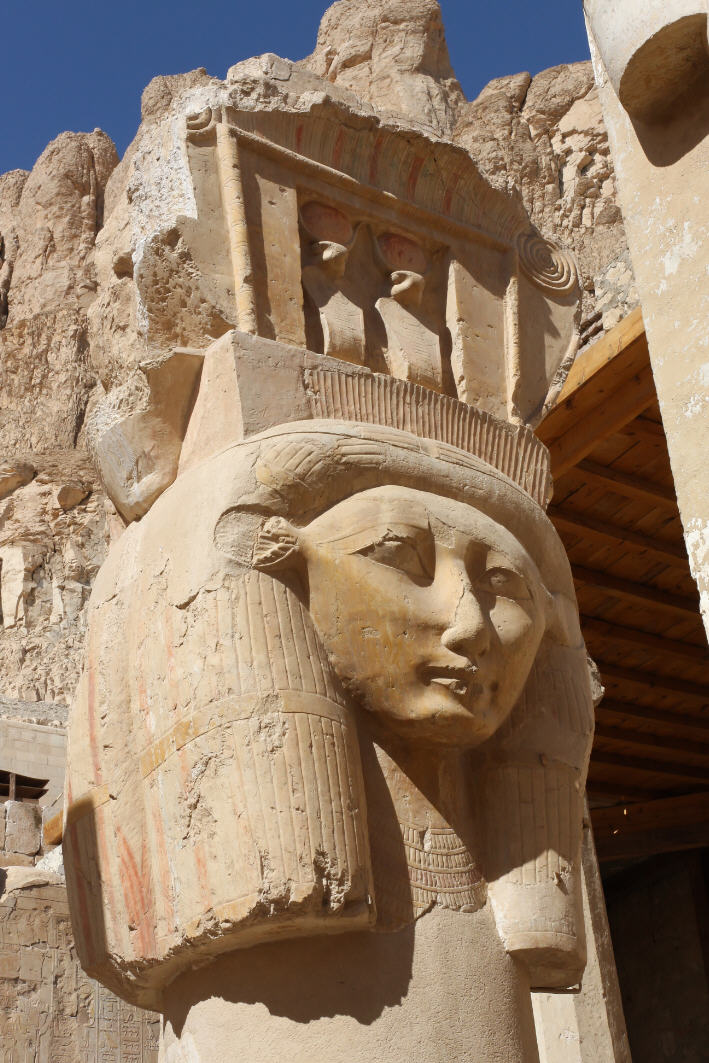
Column from the hypostyle with Hathor-Head -
above, east-side of the column surmounted by a sistrum-like shrine with two uraeus inside
below, north-side of the column with part of a lotus-flower surmounted by an Osiride figure.
|
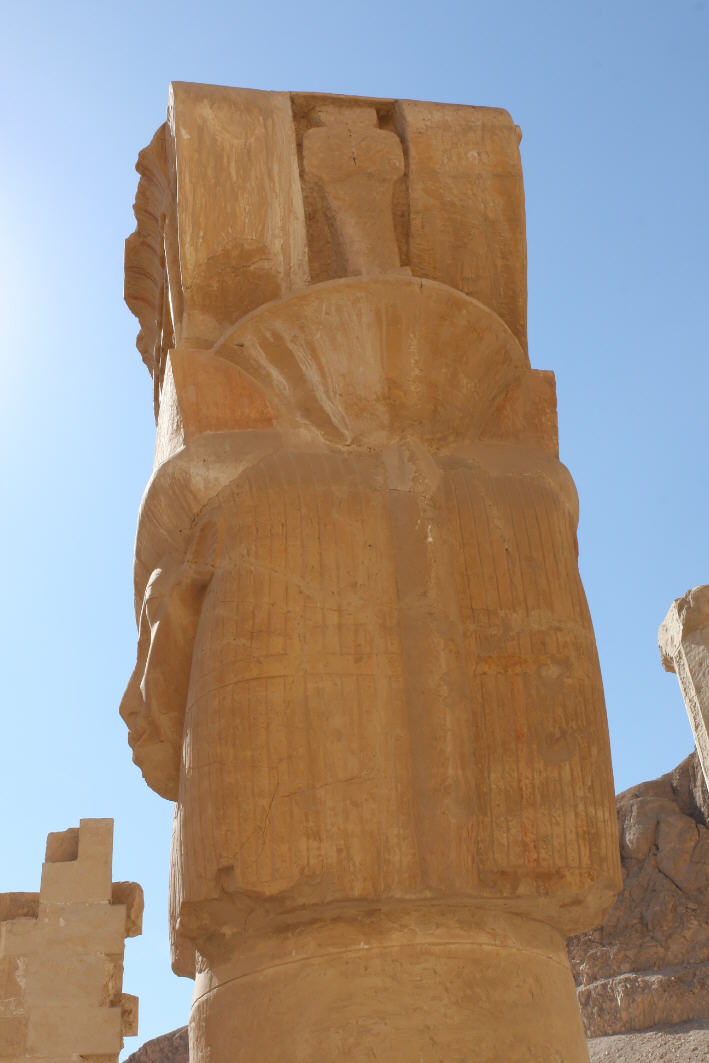
| Above and below different views of the pillars and columns of the portico of the
Chapel of Hathor. The picture above shows a Hathor capitals.
|
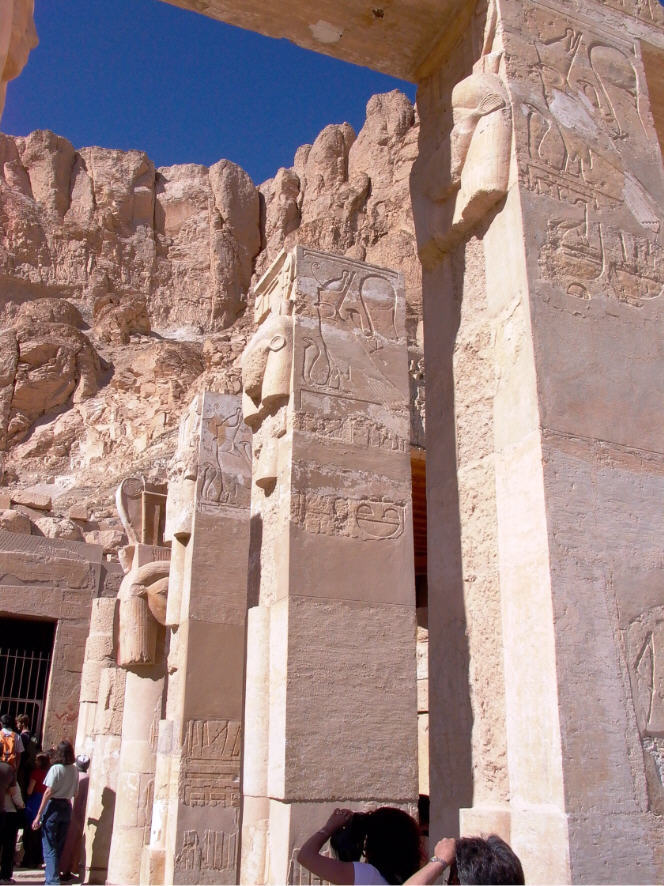
| The photo above shows the sequence of pillars and columns of
vestibule and hypostyle along the central east-west-axis of the Chapel of Hathor.
|
| Frequently overlooked are the Hathor-heads mounted on standards
aligned on the first three pillars of both sides of the processional
way (see following photo). While the Hathor-heads on the following columns welcomed the rising
sun and said farewell to it (see above) these standards are directed to the
processional way and escorted the procession into the chapel.
|
| The other sides of the pillars are decorated with a Horus,
who carries the double-crown, and a sun disk with an uraeus carrying an Ankh-sign. |
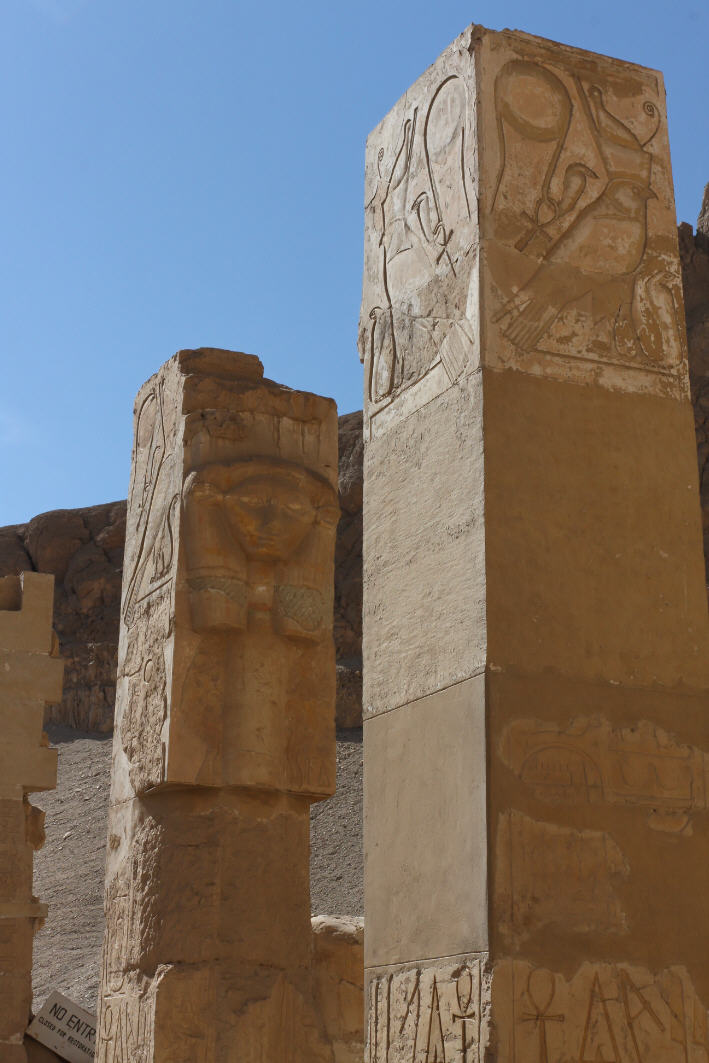
| Each Hathor-heads of these standards carries a small sistrum in
which the queen is depicted performing a cult run (see the following
photo). All of these fields are also directed to the processional way so that
the queen is moving into the chapel. Most of these fields are destroyed,
probably show the representation shows a heb-sed-run. |
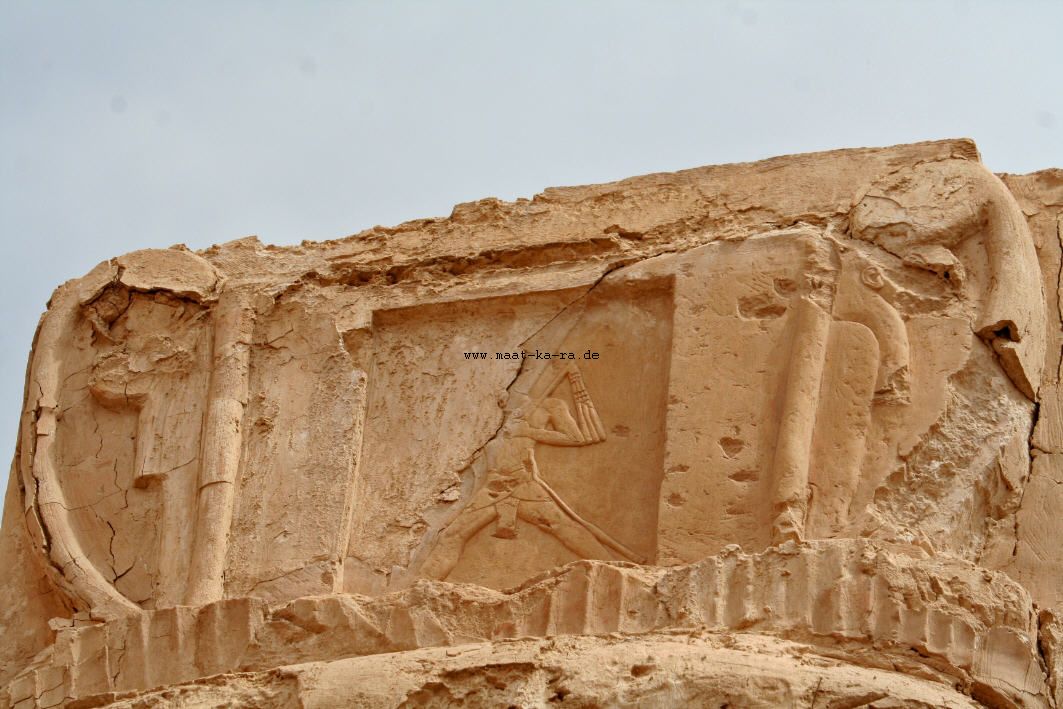
|
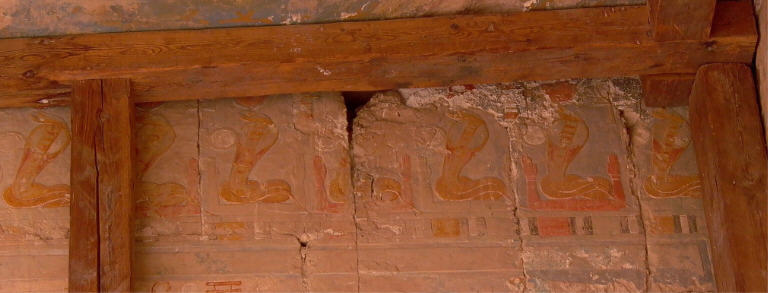
|
| Inside the vestibule as well as inside the hypostyle there are still remains of the
cryptogram of Hatshepsut (see also the paragraph "Fragments" on the page Other
Monuments) to be seen at several locations. In contrast
to the Lower Chapel of Anubis the Ka-figures had not been destroyed in
the Chapel of Hathor. The photo above shows the remains of the fries
on the western wall of the portico, the photo below shows remains on the eastern wall
of the portico. |
|
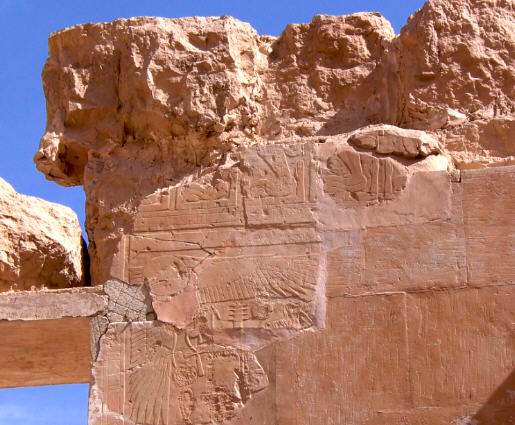
|
| On both sides, on the northern as well as on the southern inner
wall, of the vestibule scenes showing the Hathor-cow have partly survived. On
the northern wall the cow is shown leaving a shrine (see photo below; position 1) whereby the direction of motion is
traditionally.
|
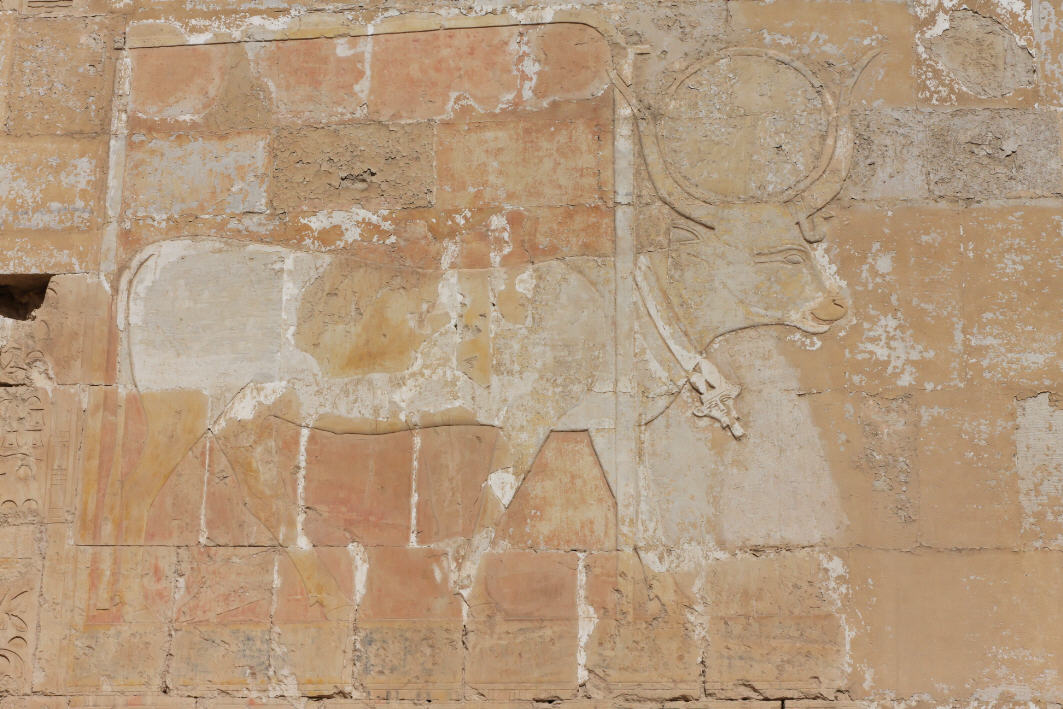
| The north-west corner shows the queen standing in front of
Hathor (see photo below; position 1), most likely the vertical line of text is to be read
as: "The King of Upper and Lower Egypt made her)?) monument for her(?) mother
Hathor, Lady of Dendera, she (!) did it [so that she is] given life like Ra." |
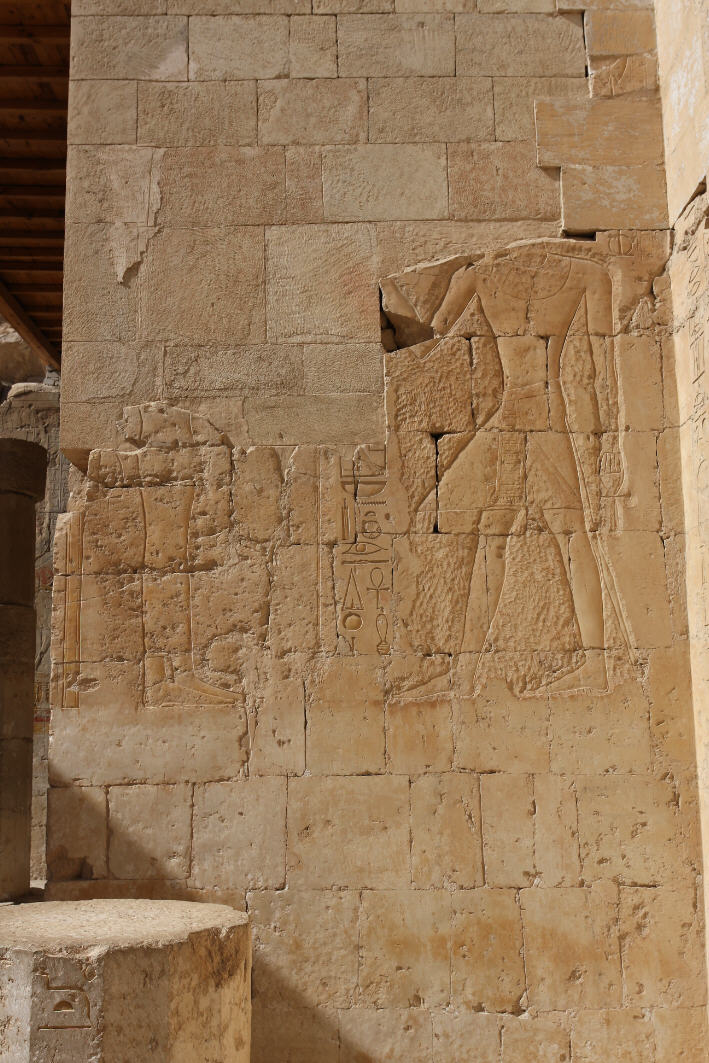
| The southern inner wall of the vestibule shows a Hathor-cow
standing in a shrine and protecting and suckling the royal child |
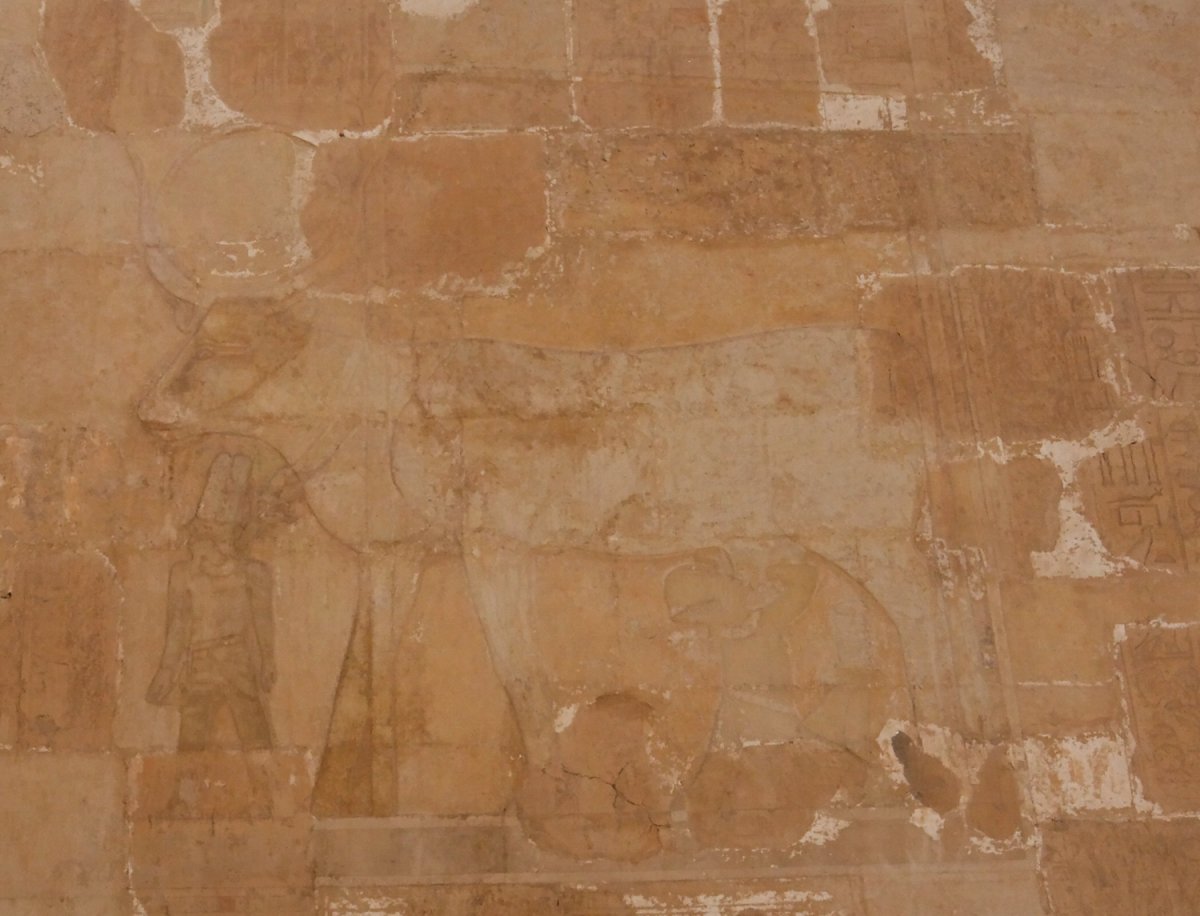
| The north wall of the hypostyle (position 2) impresses by well preserved
colored scenes. The eastern side of the wall shows the procession of the Hathor,
Lady of Dendera, to Deir el-Bahari, on the western side Thutmosis III is depicted standing in front of the goddess Hathor. |
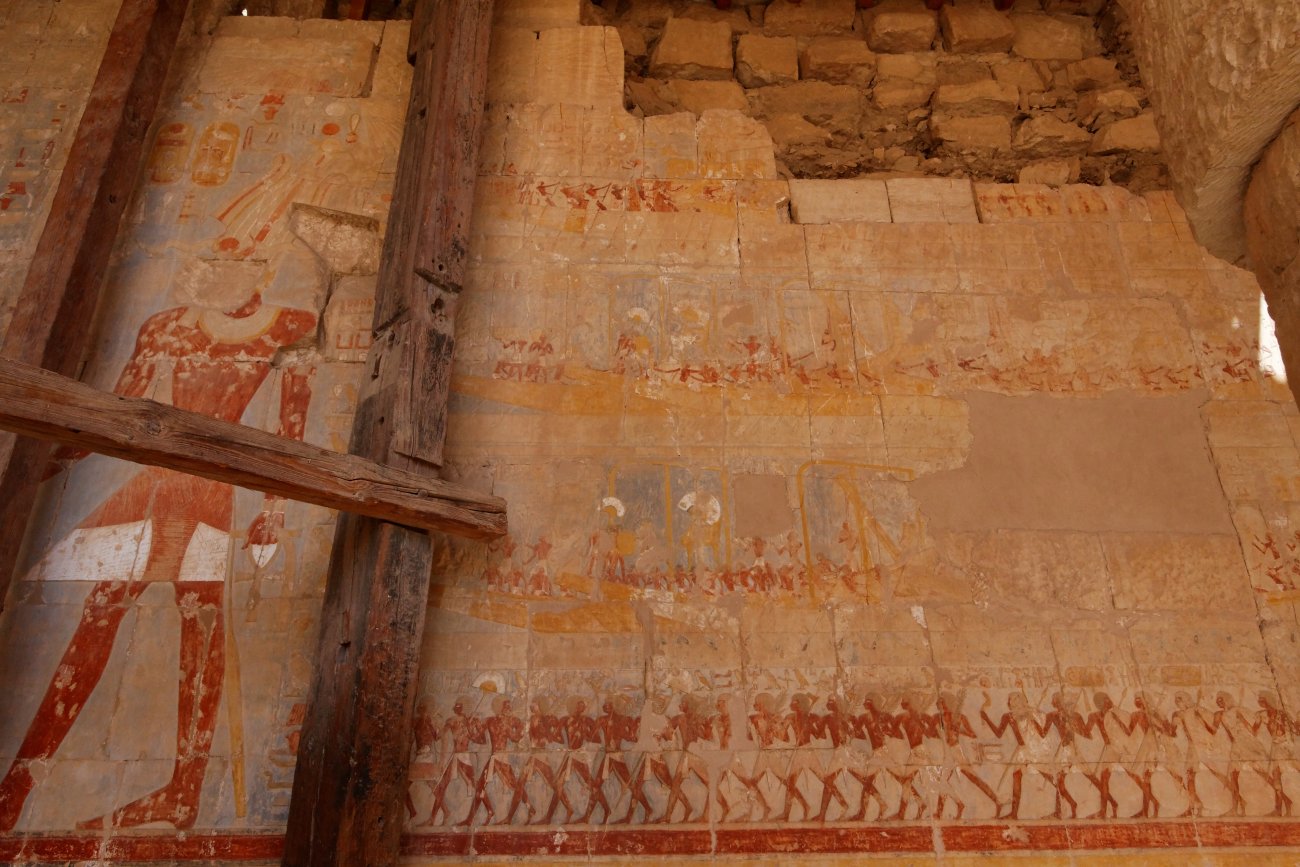
| The procession is divided into three rows with boats. Below
them a fourth row follows, in which soldiers are shown, who accompany the
procession of boots ashore. The soldiers are carrying arms, boughs of trees,
fans, sacred standards, and also take a lion along with them. The name of the
festival is given in a line of text above the boats: "... Hathor,
who is repeating birth...(..@wt-@r w@m-mswt....)". |
| A more detailed view shows that the soldiers had been selected
from at least three different troops. |
| In front soldiers from the royal ships are depicted as most
likely indicated by the military standard that shows a ship with a sphinx at the
bow and a seated king below the fan in the center of the boat. These soldiers
are armed with axes (see next but one detailed photo below). |
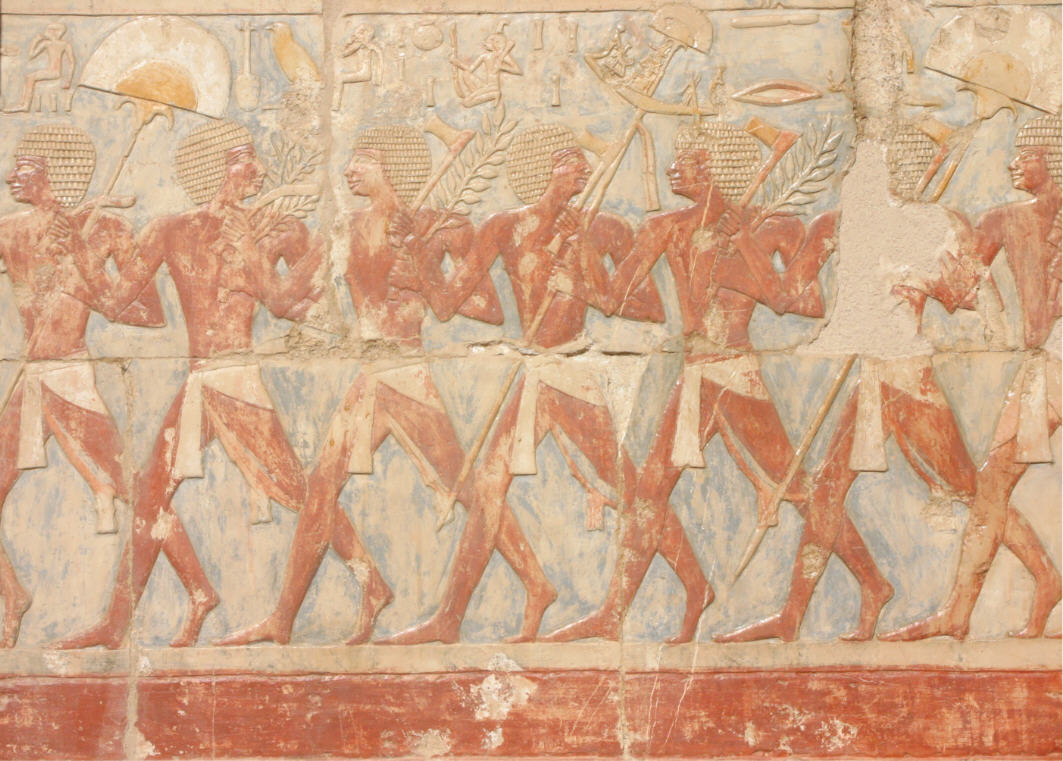
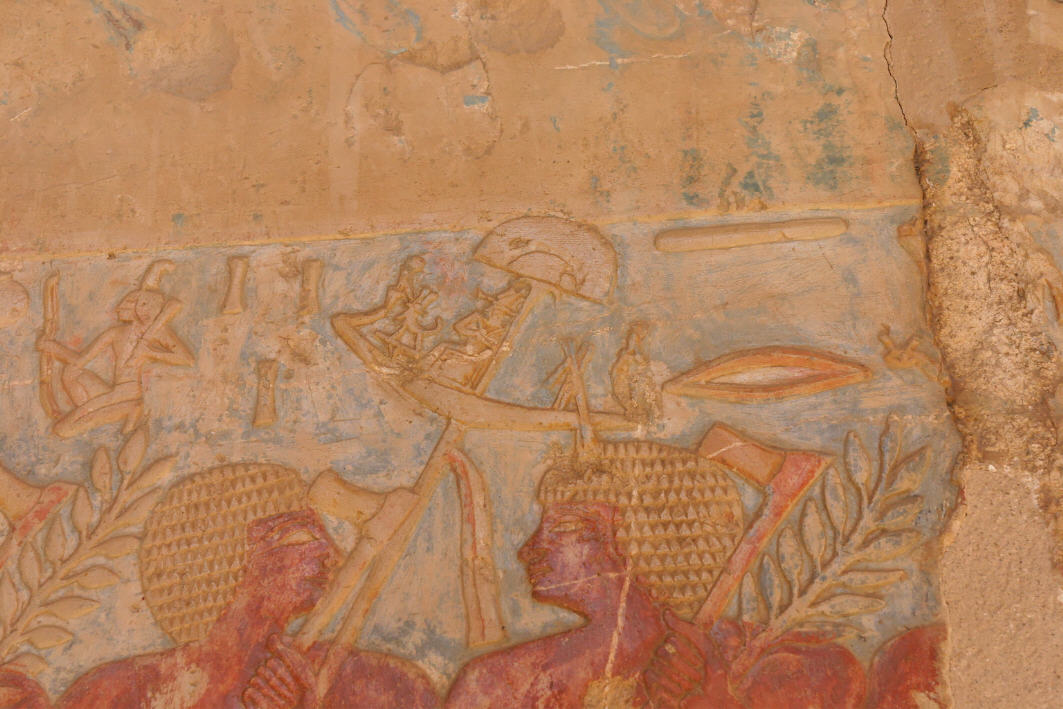
| Thereafter a group of soldiers is shown who belong to the royal
(body) guard of the king as indicated by their military standard with a royal
sphinx und the - partly destroyed - signs reading "Smsw (=
escort)". |
| This is the most heavily armed group, carrying a shield, spears
or axes or even a bow and arrows. |
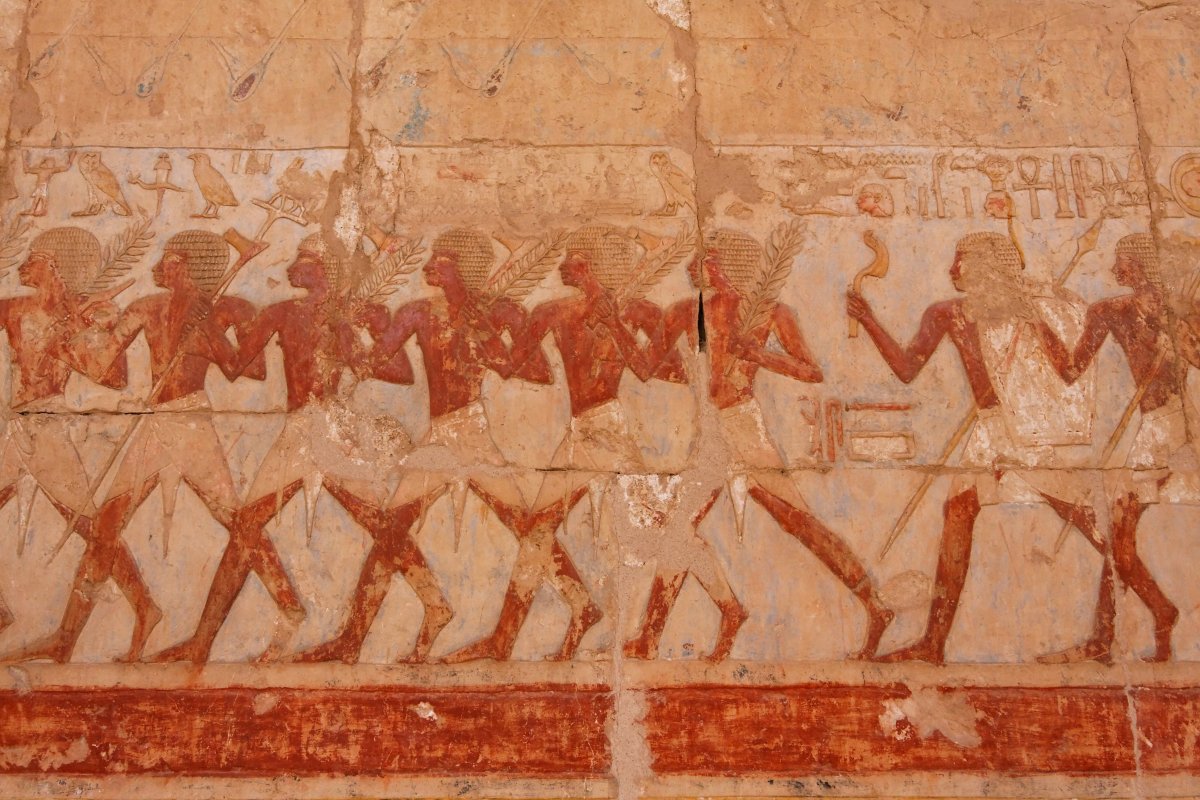
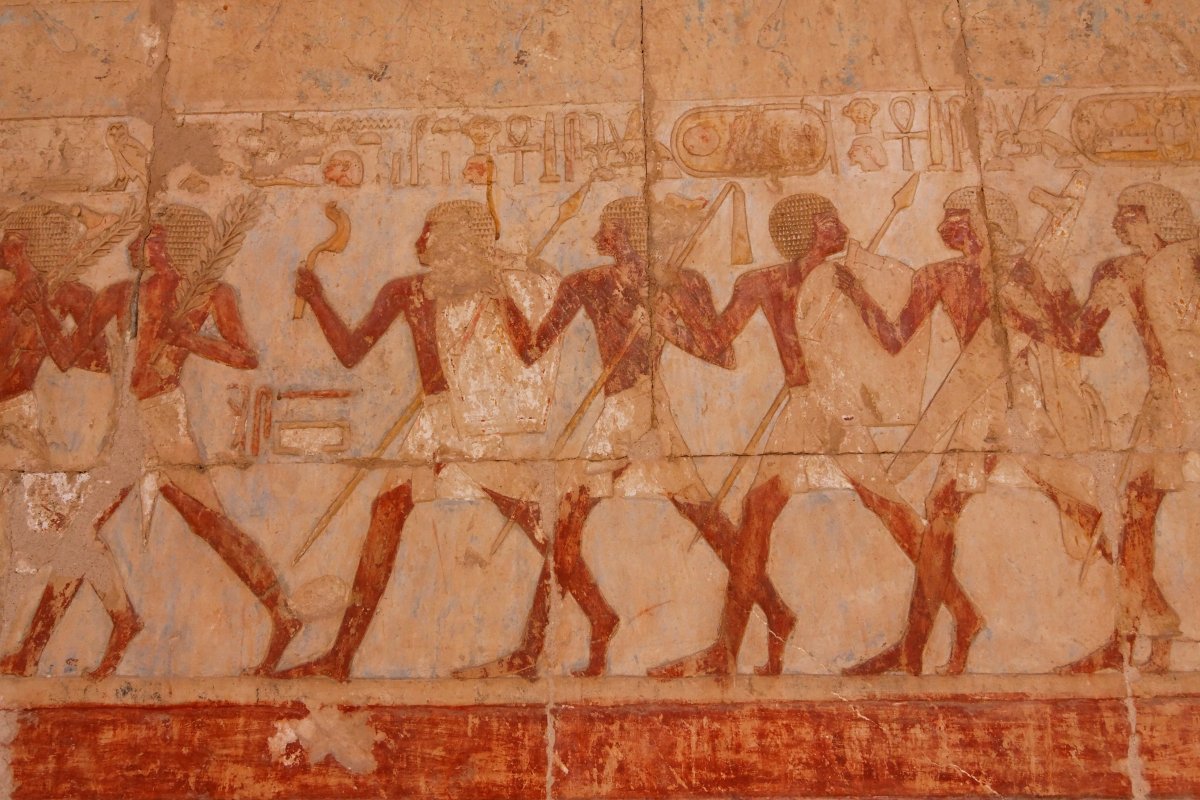
| The final group consists of Nubian soldiers armed with
boomerangs and leading a lion. |
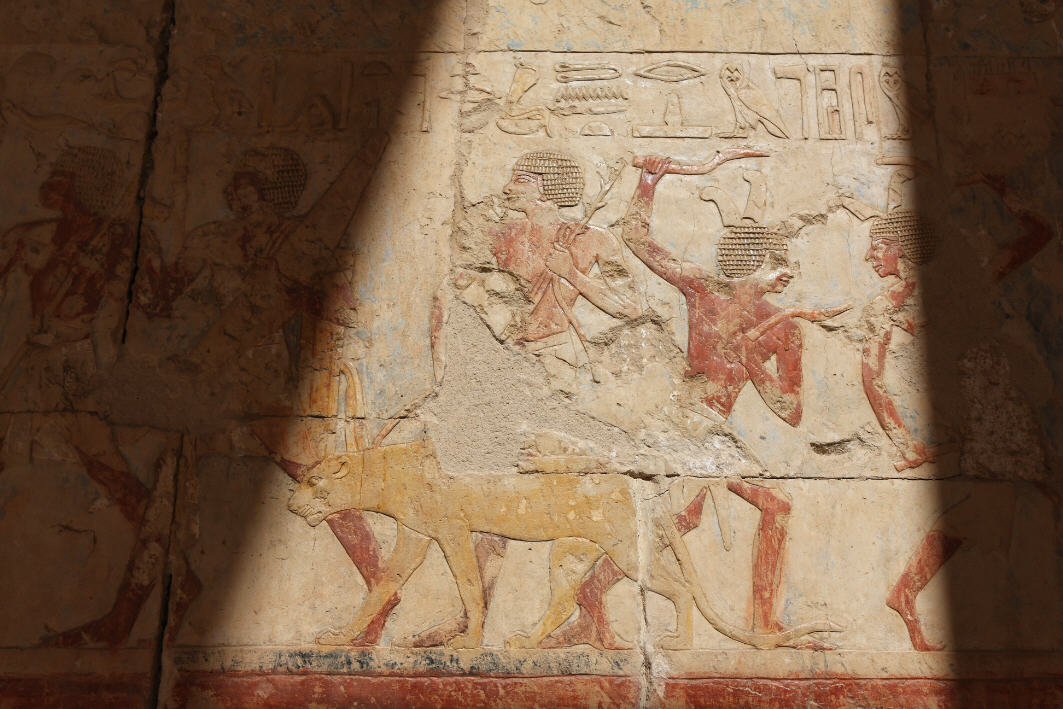
| Among the three rows of boats the upper row is very much damaged.
It contains two long boats, with a considerable number of men who row standing.
On both boats stand large shrines, adorned with draperies. Naville assumed that in one boat there were
the emblems of the goddess Hathor, in the other one those the queen. |
| The boats in the two lower rows are the escort. Here, as in the case of
the transportation of the obelisk transport depicted in the 1st portico, the queen is not
shown herself - her place is taken by her, in form of a fan (see photo below). |
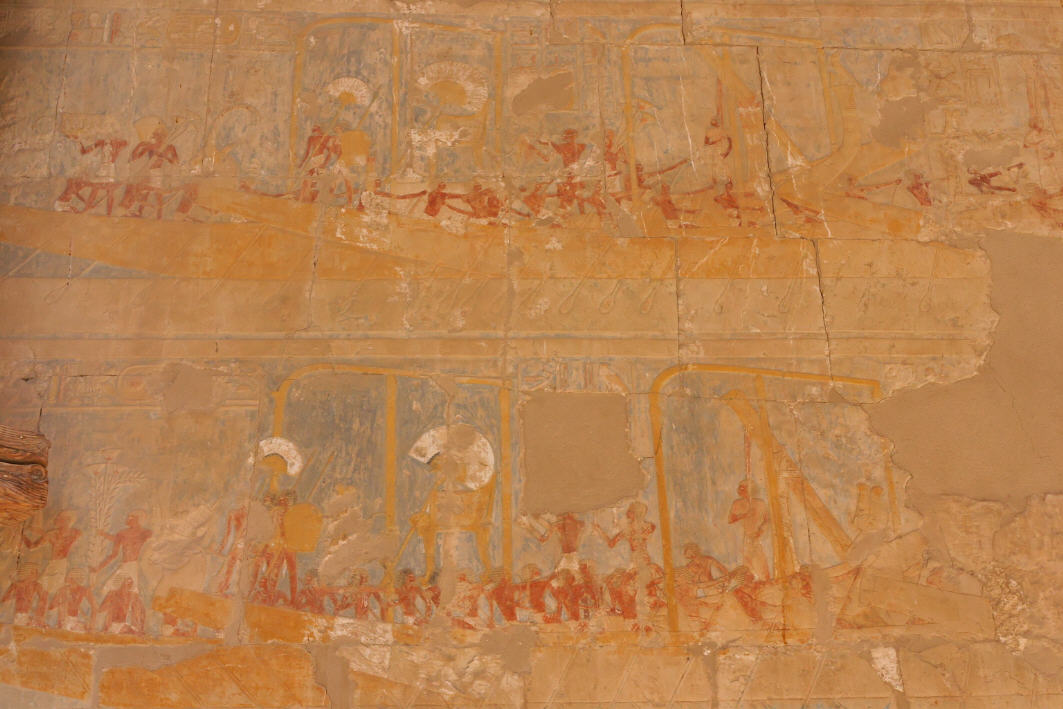
| The west side of the wall shows according to the inscription Thutmosis III worshipping (dwA nTr) the
goddess Hathor, lady of Dendera. It is noteworthy to say that his cartouche here
reads "Men-kheper-ka-Ra", the way his throne name was written during the early
years of the reign of Hatschepsut. |
| Thutmosis III has in his hand an oar. Thus, the scene might be
viewed in direct connection with the boat procession of the Hathor of Dendera to
the sanctuary at Deir el-Bahari shown just right of it. Already Kees (1977)
interpreted this scene as a representation of the first actions at the Chapel of
Hathor, which are accomplished after the arrival of the boat procession. |
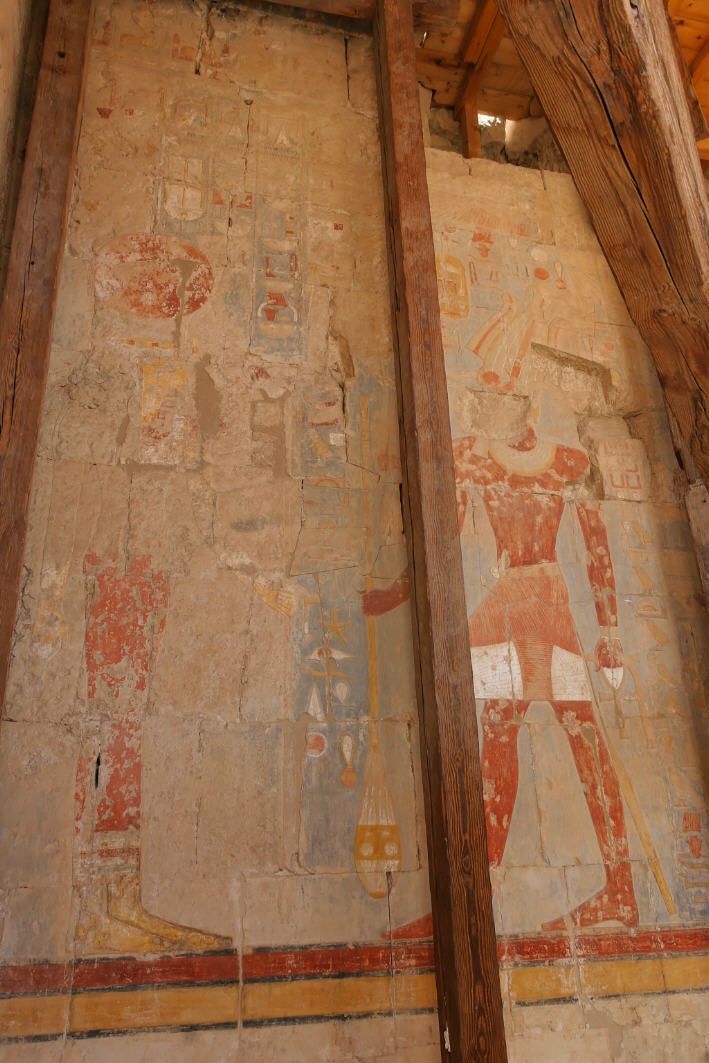
| The west wall of the hypostyle hall (position 3) shows symmetrically
2 scenes on both sides of the entrance into the chapel. In each case
on the right and left of the entrance a scene shows the Hathor cow licking the
hand of the queen (changed on Thutmosis II) who shown sitting under a canopy on
a throne. |
| On the northern and southern end of the west wall Hatshepsut
(cartouche changed to Thutmosis II) is depicted performing a ritual run before
the goddess Hathor. |
| The scene in the in the southern corner shows a ritual run with
a bird (next photo). |
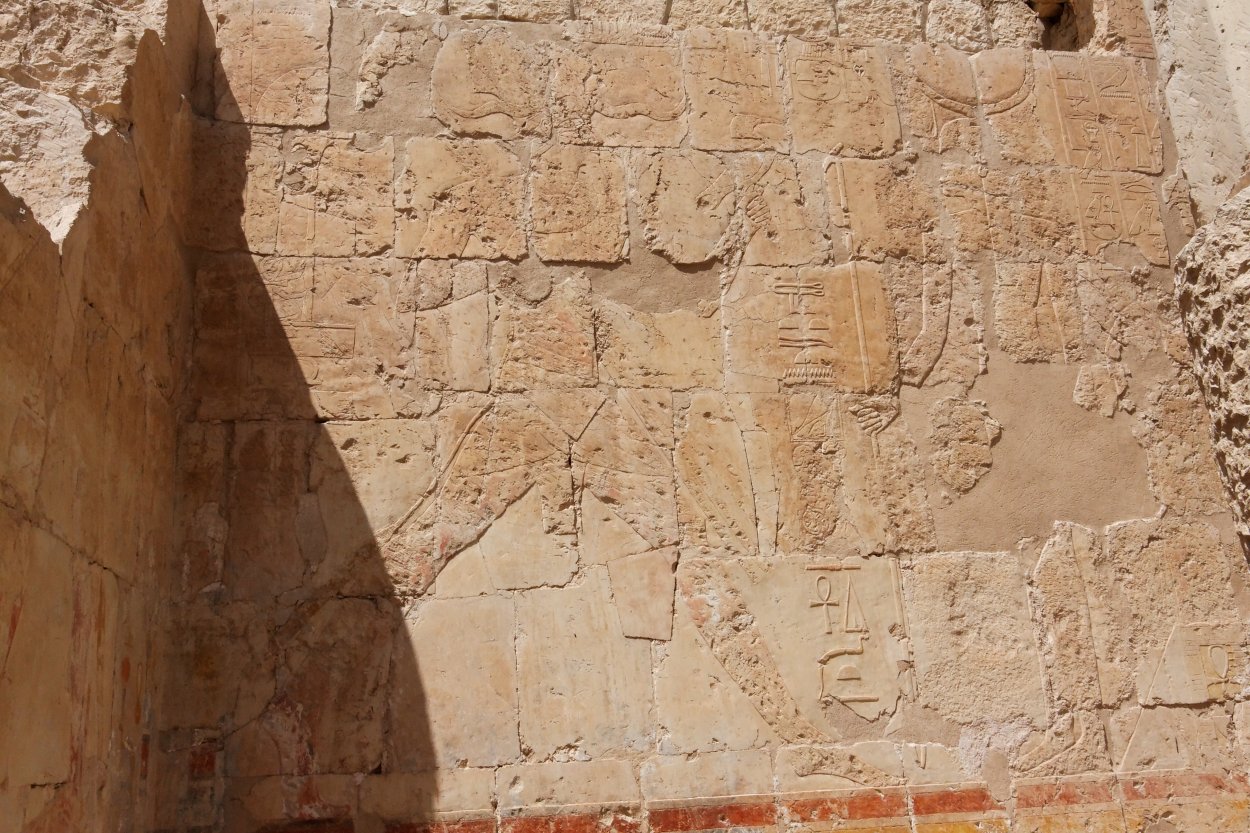
| Hatshepsut, performing a ritual run with a bird before Hathor (right, outside the part shown).
Hatshepsut wears an Atef-crown, three staffs in her right, and an Ach-bird
in her left hand. |
| The following photo shows the scene between the ritual run with the bird
and the entrance to the chapel.
Just like the mirror-image right of the entrance the Hathor cow licks the hand of
the queen (cartouche changed to Thutmosis II.) who is shown sitting under a
canopy on a throne, |
| In contrast to the corresponding scenes at the outer sides of
the facade here the queen wears in both scenes on the west wall of the hypostyle
hall an atef-crown. |
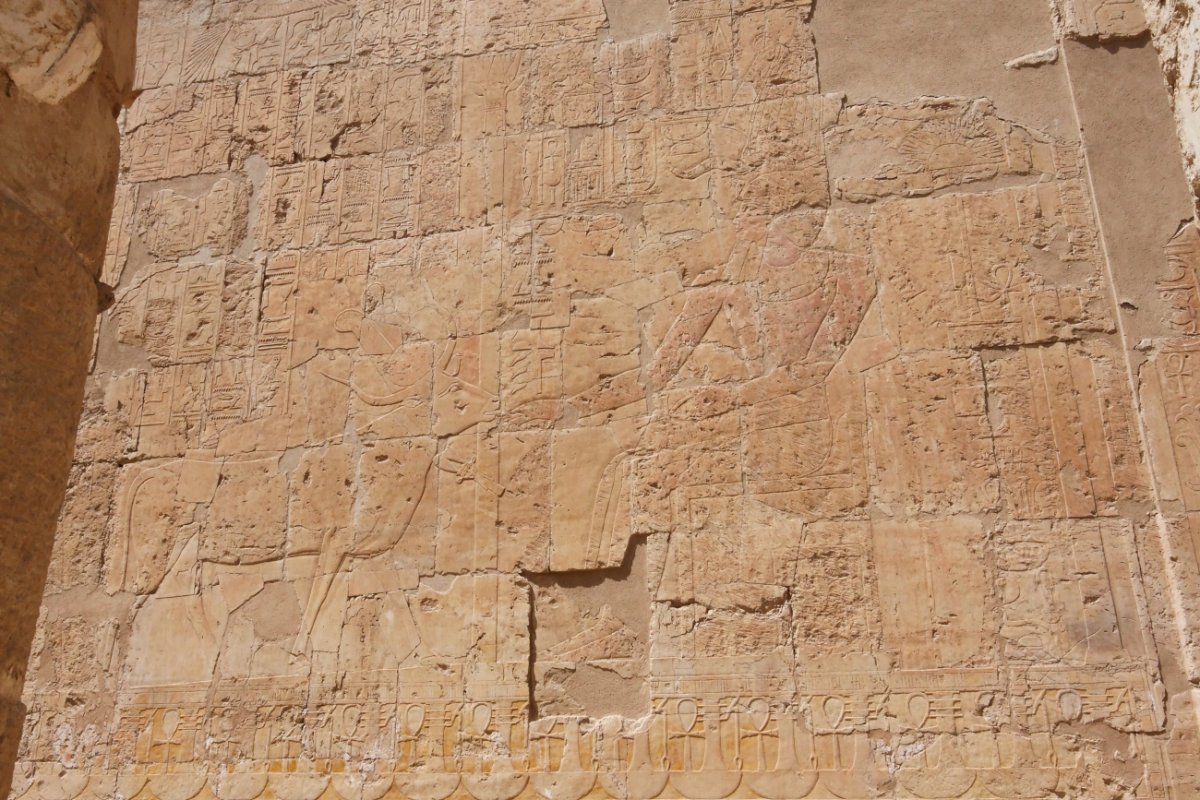
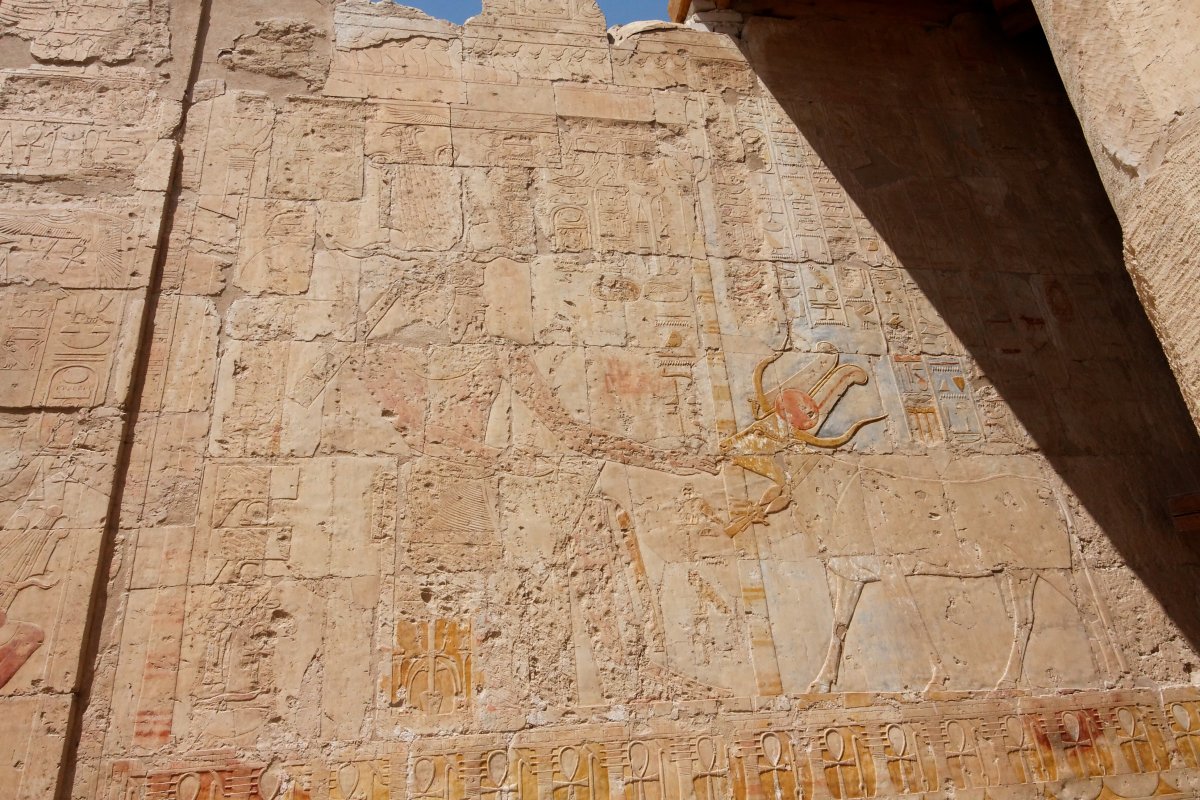
| The last scene on the western wall of the hypostyle shows a ritual run of the king who is "Seizing the Oar" (next
photo). |
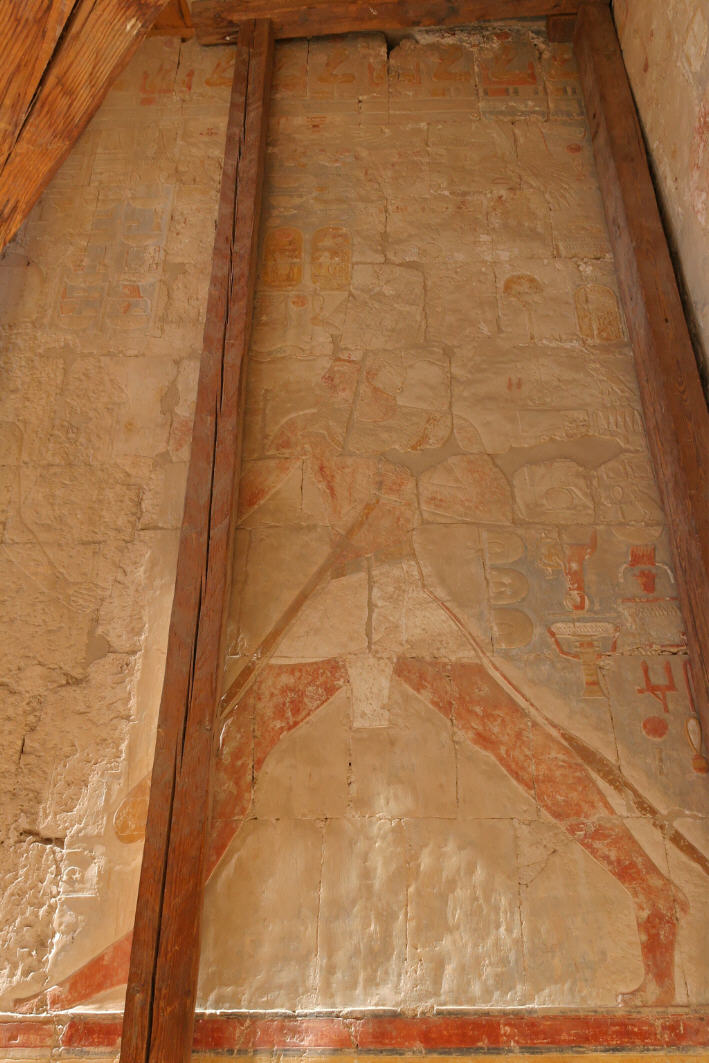
| The next photo shows the entrance to the speos.
|
| The horizontal lines directly above the doorway show on
the names and titles of Thutmosis II. The most upper line shows the wing
sun-disk from Behedet. |
| On the right door-jamb appears Thutmosis III,
on the left one Hatshepsut (changed to Thutmosis II).
|
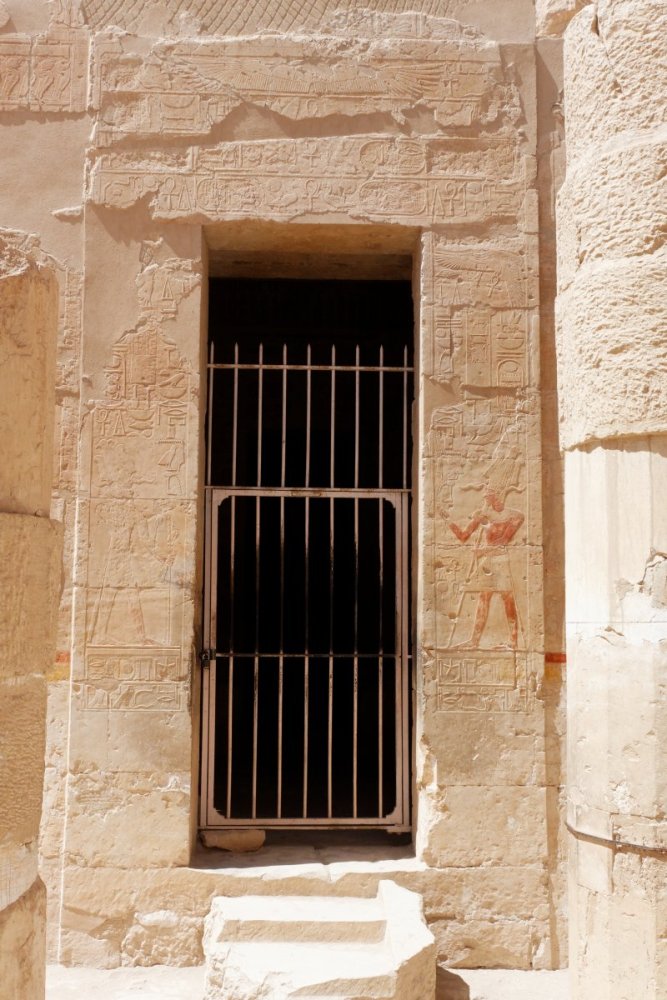
| The following two horizontal lines right and left of the
doorway contain - covered by a "pt"-sign - the name of the doorway "The door of Hatshepsut (changed to Thutmosis
II), which are brought victuals of the house of Hathor [= sbA
aA-xpr-n-Ra ...m pr @wt-@r]".
|
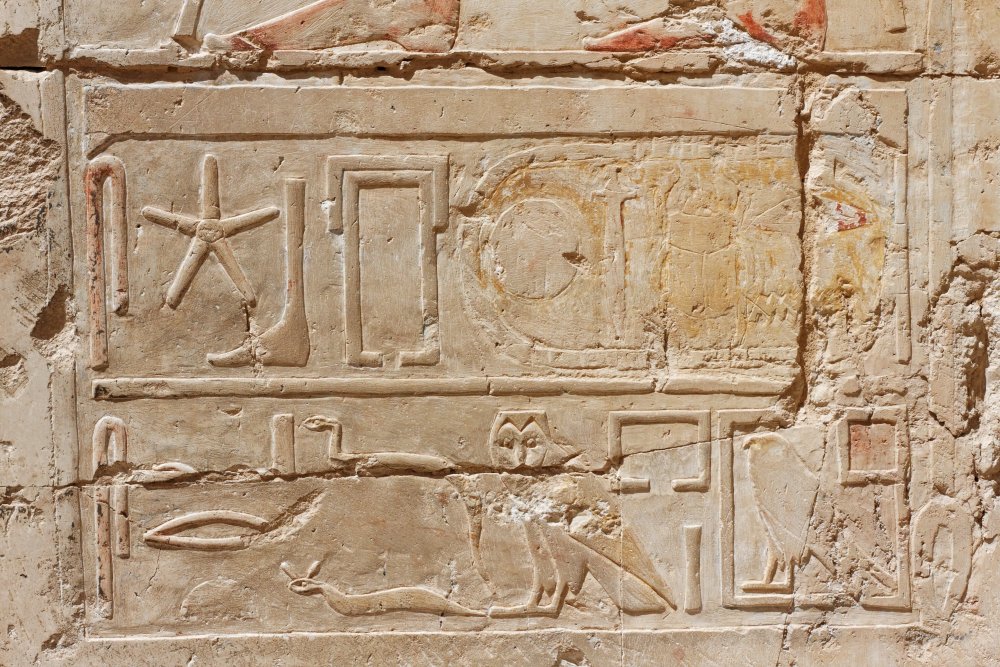
| The entrance to the chapel leads to an Ante-room supported by
two 16-sided (proto-doric) columns. Since the entrance to the chapel is closed for the public, the
two columns block the view from the entrance into the Ante-chamber so that
nearly nothing of the decoration can be seen. Only the doorways of the passage
to the sanctuary can be looked at without obstruction.
|
| In each corner of the room (not visible from
the entrance) is a deep niche, the two is on the west side goes westward into the
wall, on the eastern side of the room one goes to the north and on to the south.
Since all niches contain on the rear-wall a figure of the queen Naville assumed that all four niches were intended for statues of the queen.
According to Naville all paintings have been more or less touched. He believed
that the most original work can be seen in the southern niche. There Thutmosis
III is depicted worshipping Hathor, and right of this scene Hatshepsut (erased)
is shown before a seated Amun. |
| The following two photos show what is visible from the scene on
the south wall of the Ante-room (left) and on the north wall (right).
|
|
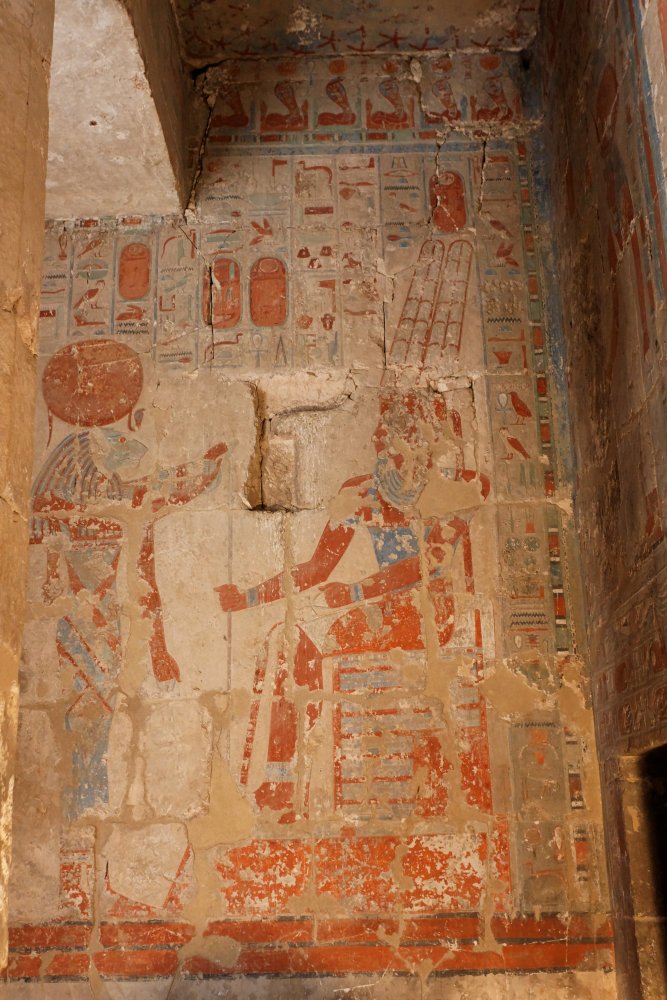
|
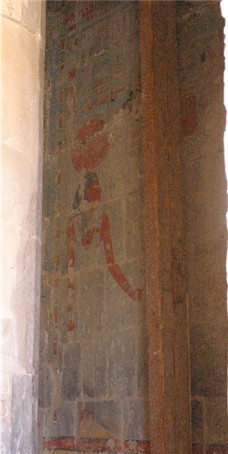
|
| Hatshepsut (her figure between the gods has been erased)
is crowned by Weret-Hekau and Amun (position 5) |
Hatshepsut (figure destroyed) offering a vase to Hathor (position 6) |
| On the inner northeast wall of the Ante-chamber we have a rare
representation, whose symbolic meaning is uncertain, the "Hitting the Ball".
This scene has been represented abundantly between the 18. Dynasty and Ptolemaic
times. Borghouts (1973) mentioned 19 locations whereby the representation in the Chapel of Hathor, Hitting the ball in
honor of Hathor, protectress of Thebes", is the oldest one known. |
| The queen (cartouche has been changed to Men-kheper-ka-Ra,
Thutmosis III.) stands before Hathor. In her left hand she is holding a
ball, in her right a wavy staff. The inscription does not explain the meaning of
the rite. |
| However, the ritual aspect is stressed in this scene by two priests standing between king and goddess,
catching balls or handing them to the king. In later representations, e.g. in the
Luxor temple (Porter& Moss, II, Room XIII, p. 327; Room II, p. 319) these priests are
missing and the king uses a straight stick. |
| According to Borghouts (loc. cit.) the ball may be interpreted as the eye of Apophis. The
ritual shown may go back to the fight between the eye of Ra and the eye of his
enemy, Apophis, which is supported by the fact that the ritual was performed
only before goddesses
(for example see Luxor-Temple, "Hitting the ball" before Hathor in room XIII,
and before Mut in room II) who are identified as the eye of Ra. |
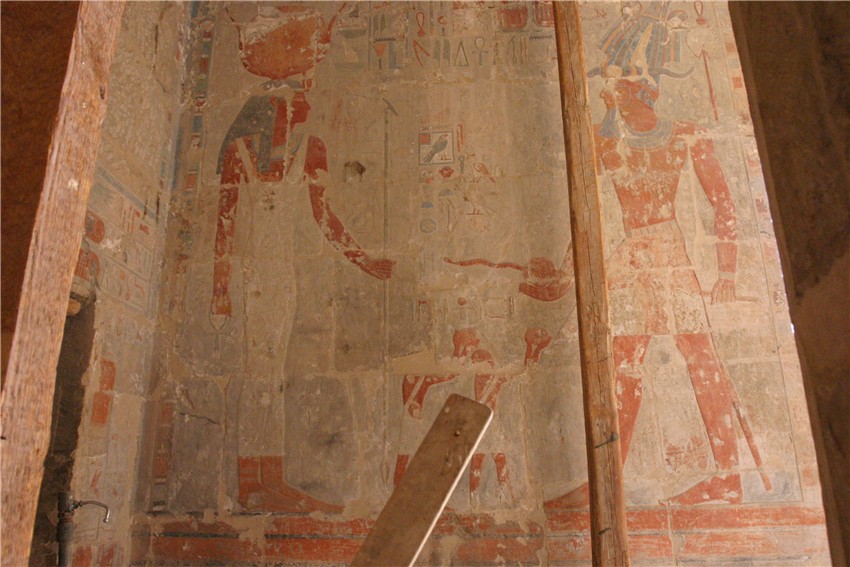
| Hatshepsut "Hitting the ball" before
Hathor (position 10). |
| On the inner southeast wall of the Ante-chamber Hatshepsut (erased)
is depicted consecrating four Meret-chests before Hathor.
|
| The decoration of the first entrance to the passage which leads
to the sanctuary is quite peculiar. The painted decoration
shows a arched roof supported by (proto-doric) columns with Hathor-capitals.
Most extraordinary are two dots somewhat below capitals, which, according to
Naville, must be
considered as two eyes. Directly next to these points a single horn branches off
on the side opposite to the passage on each pillar - on the other side of the pillar(s) there is no horn. |
| The horizontal lines above the doorway show on the left names
and titles of Thutmosis II, and those of Thutmosis III on the right. |
| The vertical at both sides of the doorway tell that "Hatshepsut
had made her monument for her mother Hathor, chief of Thebes". |
| The following two horizontal lines right and left of the
doorway contain the name of the doorway "The door of Hatshepsut (i.e. Thutmosis
II) who is joining the beauties of Hathor, chief of Thebes [= sbA
aA-xpr-n-Ra Xnmt nfrw @wt-@r hrt-tp
WAst]".
|
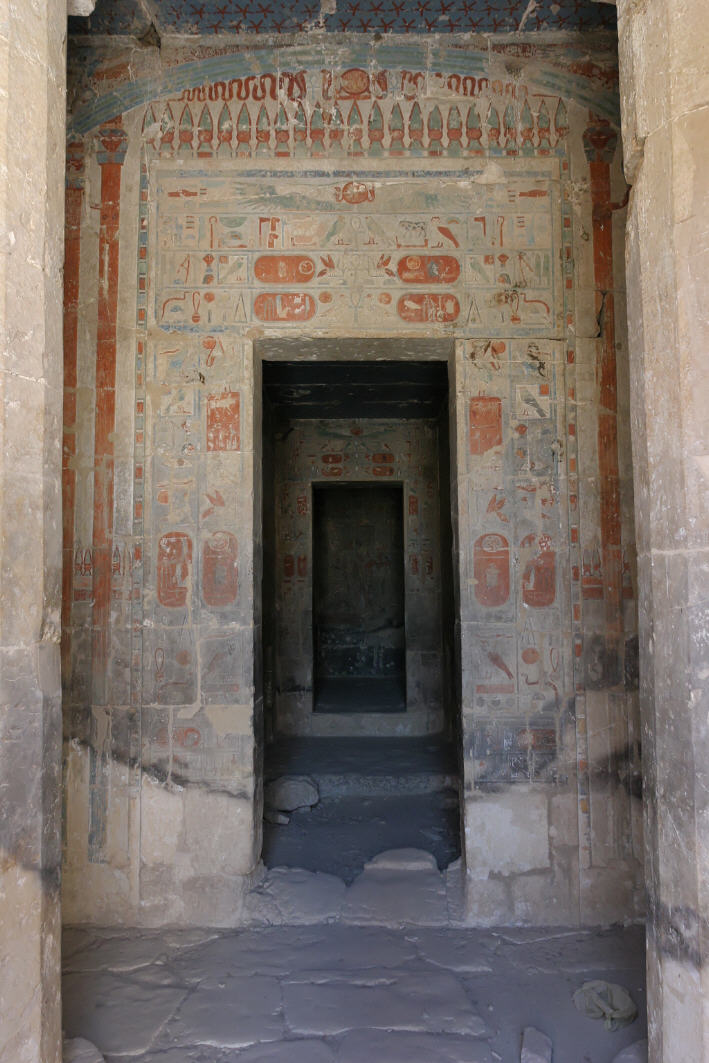
| The photo above shows the first door and the behind parts of the chapel
which has been restored during the last years. The photo below shows the
Hathor-heads of the two pillars depicted besides the royal titles on
lintel and jambs (position 7). |
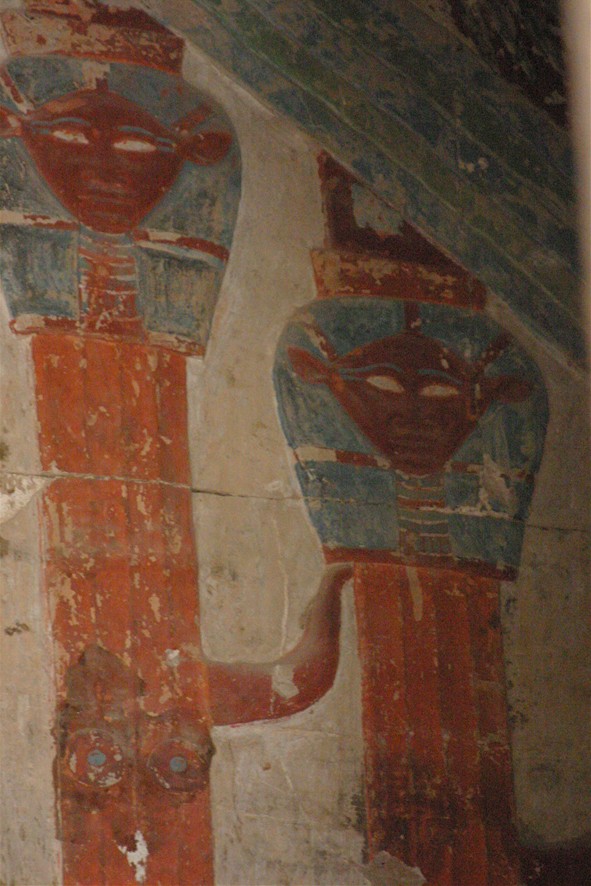
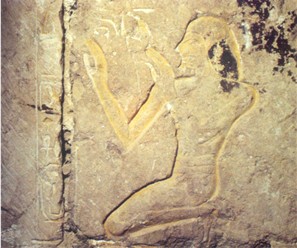
| Only here in this Chapel of Hathor), on the side wall of some niches
(position 8 and opposite niche), portraits
of Senenmut are preserved (photo by author, 2009).
|
| The west wall of the sanctuary is quite good visible from the
entrance to the speos. Under a vaulted roof Hatshepsut, with double crown, is
shown standing between Amun (left) and Hathor (right). The winged sun disk, the
great God [of] Behedet, is depicted of the scene. |
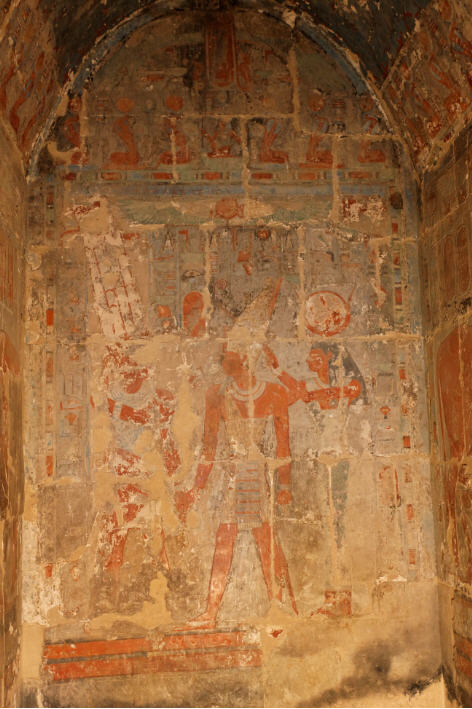
|
At position 9, at the far end of the chapel, the relief shows Hathor who
embraces the queen and leads her to Amun. |
| The Chapel of Hathor was accessible by an own ramp (see also:
History of its erection). The southern retaining wall of this ramp had
been built above an old limestone enclosure wall of the temple of Mentuhotep Nebhepetra. The layers of the old limestone
wall built by Mentuhotep have been
preserved up to a height of about 220 cm. On its northern side the ramp lent
against the retaining wall of the main temple. The southern retaining wall of the ramp to the Chapel of Hathor does
not run parallel to the retaining wall of the main temple - from the head of the
ramp at the Chapel of Hathor down to the edge of 1st. portico the width
increases by about 2 ms. |
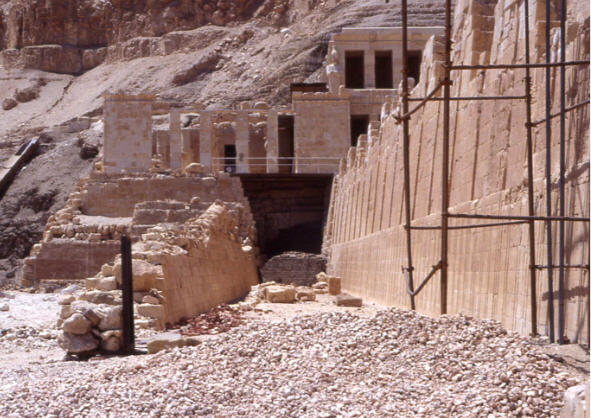
|
The remains of the southern retaining wall of the ramp which had led to the Chapel of Hathor; on the right side the photo shows the retaining wall of the
2nd terrace: The southern (left) retaining wall was built over the remains of an
enclosure wall of the temple of Mentuhotep. Straight
forward, between the retaining wall of the ramp and the retaining wall of the
2nd terrace
there are the remains of another mud-brick enclosure wall of the Mentuhotep-district.
This mud-brick wall was covered by the ramp to the Chapel of Hathor and the 2nd
terrace. |
|


































